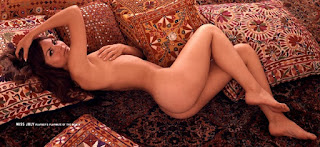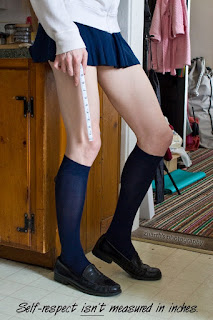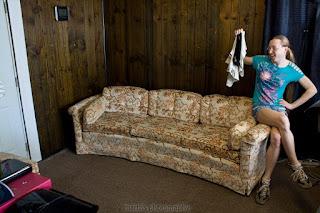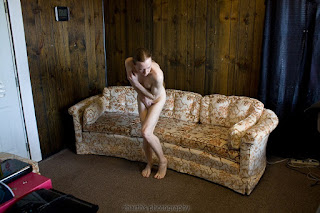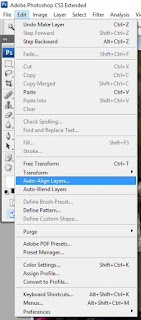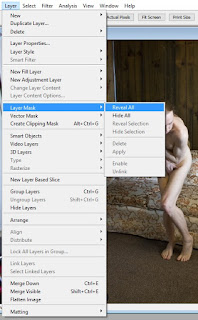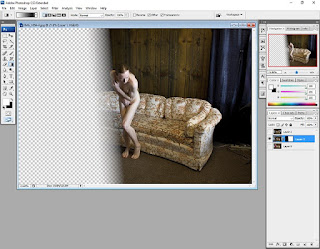It's true that I inhabit the world of erotic photography. But I'll be the first one to admit that "pin-up" culture is not really my scene. I mean, I like the concept of pin-ups - erotic images designed to be displayed like posters - but I have a problem with the glamour industry's detachment from reality. Pin-ups are too constructed, too deliberate - the makeup, the poses, the clothes (when there are clothes). The world is naturally imbued with sensuality - you don't have to try so hard to find it. That's why, rather than making a big production out of it, I like to look for the sexiness in everyday life - and integrate it into my everyday life, instead of keeping it locked away, only to be trotted out in "appropriate" situations in front of "appropriate" audiences.
Nonetheless, I've been thinking about pin-ups lately, in connection with a photo idea that I'm working on (it's not as straightforward as simply shooting pin-ups - you'll see it when I'm finished). Plus I've been hearing a lot about Playboy ever since they made the controversial decision to discontinue the publishing of nudes in their magazine last year, and their more recent conclusion that this was a mistake (to which the world muttered a collective, "duh..."). And then I stumbled upon a tumblr site [now defunct, sadly - although not too surprisingly] containing every Playboy Playmate of the Month going back to the very first issue in 1953 (which I hadn't realized featured that iconic image of Marilyn Monroe nude against red velvet).
So I thought it would be fun to browse through the magazine's past centerfolds (try looking up the Playmate for the month in which you were born!), and pick out some of my favorites. Now, this is going to be from the perspective of an artist - not a historian - so I'm focusing on the aesthetic quality of the images themselves (and how the models look), and not their significance, celebrity, or notoriety. Although, it is worth saying that that first image of Marilyn Monroe is easily one of the best centerfolds that has ever graced the pages of Playboy - from what I've seen. You'll find it at the end of the list.
Miss January - Susan Lynn Kiger (1977)
Miss February - P.J. Lansing (1972)
Miss March - Dolores Del Monte (1954)
Miss April - Sandra Settani (1963)
Miss May - Lari Laine (1958)
Miss June - Gail Stanton (1978)
Miss July - Heather Van Every (1971)
Miss August - Arline Hunter (1954)
Miss September - Angela Dorian (1967)
Miss October - Majken Haugedal (1968)
Miss November - Avis Miller (1970)
Miss December - Marilyn Monroe (1953)
Clearly, I favor the centerfolds from the earlier decades - particularly the '50s through the '70s. It's quite fascinating to look through these images and see how styles have changed over the years. The earlier images are more demure - romantic, even - often utilizing the soft focus technique that David Hamilton perfected. Beginning in the '70s, you start to see a lot more pubic hair that had previously been hidden by the model's pose or clothing - likely the result of Penthouse's influence. I had noted that an unusual proportion of the earlier models were topless, but wearing pants, and in hindsight, I suspect it was to avoid the possibility of showing any pubic hair, until such time as that became acceptable.
The centerfolds from the '80s and '90s have a very distinct look - to be blunt, these were not good decades for fashion. There is a lot of "big hair", and - particularly as you progress through the '90s - tan lines (once ubiquitous - as seen here, here, and here) disappear completely (rendering pale bodies exceedingly rare), and breast implants become more common, as the plastic, "porn star look" [regrettably] grows in popularity. Into the new millennium, airbrushing becomes very noticeable, while a large proportion of the models don a "landing strip" - though after about 2008, the clean-shaven look becomes increasingly common. A lot of people complain about that, but honestly, I think it's an improvement over the middle ground. I may be in the minority, but, aesthetically speaking, I don't mind either all or nothing (most people are very polar on this issue). But when you leave that little strip, it just looks tacky and artificial.
Of course, it's not that the models from the later years are unattractive. I just don't find them as appealing. Which is interesting, because it's not as if the women from the '50s and '60s aren't dated, too (and arguably more so). I'd like to say that theirs is a more timeless beauty, but perhaps it's purely subjective. But the more modern models look more like sex dolls than real women to me. Sure, they're designed to be "sexy". But, honestly, I don't think the designers are checking the right boxes. And I'm sure there are a lot of people out there who will disagree with me - otherwise, these things would never have become so popular.
So maybe I don't know what I'm talking about. But in my humble opinion, if Playboy wants to maintain its reputation, and rebuild their subscriber base, they should rededicate themselves to an artistic approach, instead of this commercialized, glamour industry drivel. They're worried about competing with internet pornography when they shouldn't be in the same business in the first place! And they need to reevaluate what the phrase "girl next door" means. This isn't a euphemism for "plain-looking" - there are a surprising number of beauties out there who aren't industry professionals. But, unless you live in Hollywood, the girl next door isn't going to look like a career model - with the time and money to invest in breast implants, a constant tan, and a personal makeup artist. The girl next door is a beautiful woman, but a beautiful woman you might know - not one you'd see in porn (unless you're watching amateur porn, but let's not open that can of worms right now).
P.S. I'd never given it a whole lot of thought before, but I really like the Playboy logo. The rabbit suggests an enthusiasm for copulation, but the bow tie indicates a certain level of sophistication. It says, "yes, we're animals - we're not trying to hide that fact. But we can still conduct ourselves with dignity." And I'll be damned if that doesn't mirror my own approach to human sexuality.
Wednesday, February 22, 2017
Monday, February 20, 2017
Sunday, February 12, 2017
Self-Respect
Self-respect isn't measured in inches. I wear short skirts because they're fun, and flirty. They make me feel sexy. That's not a symptom of low self-esteem; it's a celebration of confidence. I love my body, and I think it looks good. I enjoy showing it off. Have you ever noticed how shame is the tool of those who criticize revealing attire? It's because they know it well: modesty is a product of fear and loathing.
By the way, how come "modesty" (as it relates to fashion) is never applied to men? It's always a code word for slut-shaming women. Your shorts are too short. Your skirt is too high. Your shirt is too low. It doesn't cover your stomach. Where's the rest of that outfit? Men don't really have to worry about these things, because they don't have a sense of "virtue" and "purity" - by which society measures them - to protect. Nearly every time a school dress code controversy comes up (excepting the rare and relatively unspectacular issue of boys growing their hair long), it's about what the girls are wearing. Except, it's not really about what the girls are wearing. It's about how hot and bothered by what the girls are wearing the policy makers are. It's a damn shame they can't just take responsibility for their own feelings, instead of trying to punish others for making them feel dirty.
---
On a related issue, I think the problem with a lot of feminist rhetoric is that in the process of calling out the abusive aspects of the sexual environment through which women must navigate, male sexuality is vilified, without providing men with a paradigm of how to relate sexually to women in a way that is not abusive. Too often it comes down to, "when a man looks at a woman, he is victimizing the woman", and as someone who is sexually attracted to women, I am offended by that. It doesn't mean I don't think there is any problem with male culture, or the way men treat women. It's just that, being sexually attracted to a woman isn't part of that problem. Having the feelings is not wrong, or hurtful to anyone. It all depends on how you deal with them - whether you use them as a shallow excuse to treat women poorly, or not.
Because when the former happens, we get these disgusting situations where the only expression of male sexuality that is visible (and talked about) is the abusive kind, and women learn to associate male sexuality with abuse. So that the problem with girls wearing short skirts, for example, becomes the expectation that men will leer at them. And the response to that is, if you think a girl in a short skirt is sexy, you're being a pig. But that's not true. And it's offensive to us men (and women) who can appreciate the sex appeal of a girl in a short skirt, without translating that into behavior that makes the girl feel uncomfortable or victimized.
"...the [men in my life] who like women sometimes have the pure and honorable thought that a woman they see is attractive and sometimes they even fantasize, but they know how to act appropriately toward those women and respect their boundaries."
- Madison Kimrey
This girl gets it. We need more messages like this - they're way too rare. Messages that tell men that it's okay to be sexually attracted to women (because it's unavoidable - no force in the universe is strong enough to prevent men from fantasizing about women), and that emphasize the difference between perfectly acceptable and definitely unacceptable ways to handle those feelings (instead of just calling out the latter and leaving it at that). Because if you don't give men a positive outlet, they're going to have no choice but to resort to a negative one. Tell a man he's evil because he has those feelings, and he might just be inclined to prove you right.
In a different discussion, on sexualized Halloween costumes (an issue that's near and dear to my heart), Madison Kimrey considers a typical example of the conservative approach, in which an offended bystander complained until the store (inevitably concerned with bad PR and prioritizing damage control) pulled the offending product. She offers her criticism, saying that "instead of appealing to the store to provide more choices for girls, [the offended party] instead chose to limit the choices of others." This is the rational and humanitarian approach to this disturbing phenomenon (that I have been advocating for at least the last five years). So why do I never hear anybody taking this stance? I think I like this girl.
---
I came across this twitpic while searching for inspiration re: dress code violations, and I thought it was brilliant:
"If anything, school taught me that this was the dress code for guys vs. the dress code for girls."
The most disturbing thing about this image is that it's only a slight exaggeration. I swear, I've seen it with my own eyes - boys regularly cavorting in their underwear, while girls are dressed head to toe (to preserve their "virtue"). Because girls' bodies are "sexualized". I don't really like that word, because human beings are sexual creatures by nature, but in terms of how society views these things - if a boy's skin is showing, it's just a body. But if a girl's skin is showing, it's scandalous. Even if we're just talking about children. The grand irony, however, is that this rule is flipped completely upside-down at the swimming pool - males are forbidden from wearing briefs, while females can be expected to be donning tiny triangles attached with strings. Again, even where children are concerned. I don't understand human psychology sometimes...
---
But, there is a bright patch amidst this sea of darkness:
Schoolboys allowed to wear skirts under new 'gender neutral' uniform rules
How I wish I could have grown up today (or maybe in a few more years, when this trend starts to snowball - fingers crossed). One of my most treasured fantasies is to relive my high school prom, wearing a stunning dress and heels.
"Diversity campaigners have warned current policies risk discriminating against lesbian, gay, bisexual and transgender pupils (LGBT)."
I hope this trend trickles down to swimming pools, too - I've made this same argument against the sexist double standard regarding men's swimming briefs for several years now. If girls can do anything boys can do, then boys can do anything girls can, too.
"This change follows requests from a small number of families."
And you can bet there are a large number of families ready to protest it, because they're uncomfortable with the fact that they can't force the world to adhere to their small-minded ability to comprehend what's going on around them. What's ironic is the fact that they'll protest this expansion of freedom as if it were a restriction on their own choices. "Duh, lib'ruls forcing me to acknowledge that not everyone wants to live the way I want them to, instead of just letting me go on dictating other people's lives, the way we've been doing it for generations." Does it really take a genius to figure out that your choices don't encompass "choosing" other people's choices for them? It's baffling, the stupidity of mankind.
But you know what? I don't give a fuck what your opinion on a boy wearing a skirt is. If that boy wants to wear that skirt, I'll defend to the death his right to do so. Because that's the American way. And I don't look too kindly on insinuations that there's anything wrong with it, either. Every day, we exert enormous amounts of pressure on people to conform to ill-fitting stereotypes, and it causes undue stress and trauma. I don't care what your narrow-minded, conservative justifications are - if you're contributing to this toxic environment, then you're a horse's ass. There's no two ways about it.
Tuesday, February 7, 2017
How To Clone Yourself
A Step By Step Guide
As promised! In order to create a clone shot, you're going to need to take a series of pictures of you in different positions, without moving the camera, and then you're going to combine those images in Photoshop (or some other image editing program). To illustrate this process, I am going to try to replicate this image I found on deviantART that I've always liked. It's humorous, a little bit kinky (without being explicit), and will give me an opportunity to be both nude and try on a couple different outfits. Let's get started!
1) Set up the tripod
You're going to need a tripod for this, so you can keep the camera steady between shots. The more the scene changes from one shot to the next, the harder it's going to be to stitch them together in the end. This includes lighting, which you should keep in mind if you're relying on window light, or shooting during twilight, etc.
When setting up your scene, you should apply the usual rules of composition for a more aesthetically pleasing image, but with the added challenge of imagining yourself positioned somewhere within the frame - not in one place, but in two or more places (so make sure you leave enough room!). It's important to remember to be extra careful not to move or bump the tripod while shooting, to make your post-processing job much easier. (But don't despair - I tell myself this every time, and I still manage to bump the tripod sooner or later. As long as it's not too drastic, the damage can be mitigated in post).
2) Shoot yourself
Pose within the frame of your image (like you would in any self-portrait, or like your model would in a regular portrait), and take a picture using the camera's self-timer function, or remote shutter release. Take multiple shots if necessary to ensure you get one that's really good (tip: self-portraiture relies heavily on trial and error) - this is where any modeling experience you have will come in handy, in terms of finding your best angles.
3) Shoot your clones
Now, repeat the previous step (more than once if desired), but with you in a different part of the frame. Think of ways you can interact with your clones to create a more compelling image, so it's not just you standing in different spots. But be forewarned, although it is not impossible for you to (appear to) come into physical contact with another clone, pulling this off requires very careful positioning and expert Photoshop skills. If you want to stick to easy mode (which I recommend if you're a beginner), then you'll want to keep your clones separate - which means no overlapping, and you should take care that distinct shadows cast by any of your clones don't interfere with the positions of any of your other clones (although a lot of times you can flub this - most people won't be scrutinizing your image with a magnifying glass; just try to avoid anything glaringly obvious).
If you're feeling overwhelmed at this point, don't be discouraged. All of these are things that you'll get better at dealing with over time, the more you practice. Sometimes you'll get lucky, and have an easier job, and other times there'll be little details you hadn't noticed that get in your way. If you have bad luck the first time, just relax, and try it again (from the start) later.
Tip: if you're trying to model different people (as opposed to going for that creepy "attack of the clones" look), then try wearing different outfits, changing your hair, adding/removing glasses, etc. If you're really ambitious, you can even change your nail polish from one shot to the next - but be aware of changing light conditions!
4) Choose your shots
Chances are, unless you're perfect (and nobody is perfect), you took several variant shots of each clone (maybe even hundreds - I've been there), in the process of finding a pose that works. Now it's time to pick out the best ones, that you'll be using in the final product. You should have at least one of each clone, although it's okay to have alternates (and sometimes this is necessary, as different poses will complement each other differently, or may cause issues with overlapping) - but be warned that the more you have, the more work you'll have to do later.
Note: you can perform this step either on the camera itself, or after you transfer your images to a computer - whichever you prefer. I generally like to look at them on the computer before making my decisions, because you can see the details better on a larger screen.
5) Edit your shots (if necessary)
I usually like to apply some basic edits to my shots in Lightroom (like Punch, or Auto White Balance). But I recommend you use a light touch, because each of your chosen shots needs to be consistent with one another. This is the time to compare your shots and make sure their levels and tones all match. If one is much lighter or darker than the rest, for example, you'll need to even it out. One thing you do not want to do right now is crop your images. If you're not happy with the framing, you'll be able to crop the finished product later, after merging the individual shots.
6) Merge the clones
This is where the magic happens!
(I have to apologize for not just recording a video tutorial, which would undoubtedly have been easier to follow. But for some reason I am profoundly inept at recording videos on the computer. I don't understand it).
a) Open one of your images in Photoshop (or a comparable image editing program). This will serve as the "base" image that you'll be adding the rest of your clones to. Which image you choose is up to you - your choice may make your work flow easier or harder, but the ability to predict this accurately can only come from experience.
b) Open each additional image one at a time, and paste each one (Select All + Copy, then Paste) as a new layer onto the base image. (You can double-click the bottom layer labeled "Background" to unlock it).
c) At this point, you can use Edit -> Auto-Align Layers to line up the shots, in case you accidentally bumped the tripod during shooting. Ideally, you shouldn't need to do this, but it doesn't hurt.
d) Make all the layers invisible except for your base image and the first clone.
e) Apply a Layer Mask to the first clone image. (It doesn't matter if you choose Hide All or Reveal All - either way the process will be the same, just inverted).
This is what the Layer Mask looks like in the Layers tab. (It will be black instead of white if you picked Hide All).
f) Now for the hard part. Draw on the Layer Mask (make sure you click the Layer Mask in the Layers tab before drawing on the image) to reveal (white) or obscure (black) parts of the image it is attached to. Try starting with a gradient, applied between the two figures, and then use a brush for more fine tuning, if needed. You want to make the clone visible over top of the base image, while smoothly blending things like variable shadow patterns. This is something you just have to do a lot of to develop a good instinct for.
g) Once you're happy with the juxtaposition of your first clone against the base image, make the next layer visible, apply a Layer Mask to it, and repeat the last step. Continue until you finish the last clone.
This is what it should look like when you're done. You can toggle the visibility of the layers (as I've done in the preceding two images) to see how much of each layer is visible. You can also alt+click on the Layer Masks in the Layers tab to see them full size.
This is what my final Layer Masks look like in the Layers tab. Yours, however, may look different, as each one will be unique, based on the images you're using.
7) Apply finishing touches
At this point, you might want to save your work in case you decide to make any changes in the future. More importantly, you'll need to export a jpg file (or other image format) of your finished product. You can now reopen this image in Lightroom to make final adjustments (if necessary), such as cropping. If your images weren't perfectly aligned (e.g., you bumped the tripod) before auto-alignment, then you'll probably have a tiny bit of white space along some of the edges that you'll want to trim away. That's it. You're done! You can resize your image if you like, add a watermark, and publish it to the net. You've just cloned yourself!
As promised! In order to create a clone shot, you're going to need to take a series of pictures of you in different positions, without moving the camera, and then you're going to combine those images in Photoshop (or some other image editing program). To illustrate this process, I am going to try to replicate this image I found on deviantART that I've always liked. It's humorous, a little bit kinky (without being explicit), and will give me an opportunity to be both nude and try on a couple different outfits. Let's get started!
1) Set up the tripod
You're going to need a tripod for this, so you can keep the camera steady between shots. The more the scene changes from one shot to the next, the harder it's going to be to stitch them together in the end. This includes lighting, which you should keep in mind if you're relying on window light, or shooting during twilight, etc.
When setting up your scene, you should apply the usual rules of composition for a more aesthetically pleasing image, but with the added challenge of imagining yourself positioned somewhere within the frame - not in one place, but in two or more places (so make sure you leave enough room!). It's important to remember to be extra careful not to move or bump the tripod while shooting, to make your post-processing job much easier. (But don't despair - I tell myself this every time, and I still manage to bump the tripod sooner or later. As long as it's not too drastic, the damage can be mitigated in post).
2) Shoot yourself
Pose within the frame of your image (like you would in any self-portrait, or like your model would in a regular portrait), and take a picture using the camera's self-timer function, or remote shutter release. Take multiple shots if necessary to ensure you get one that's really good (tip: self-portraiture relies heavily on trial and error) - this is where any modeling experience you have will come in handy, in terms of finding your best angles.
3) Shoot your clones
Now, repeat the previous step (more than once if desired), but with you in a different part of the frame. Think of ways you can interact with your clones to create a more compelling image, so it's not just you standing in different spots. But be forewarned, although it is not impossible for you to (appear to) come into physical contact with another clone, pulling this off requires very careful positioning and expert Photoshop skills. If you want to stick to easy mode (which I recommend if you're a beginner), then you'll want to keep your clones separate - which means no overlapping, and you should take care that distinct shadows cast by any of your clones don't interfere with the positions of any of your other clones (although a lot of times you can flub this - most people won't be scrutinizing your image with a magnifying glass; just try to avoid anything glaringly obvious).
If you're feeling overwhelmed at this point, don't be discouraged. All of these are things that you'll get better at dealing with over time, the more you practice. Sometimes you'll get lucky, and have an easier job, and other times there'll be little details you hadn't noticed that get in your way. If you have bad luck the first time, just relax, and try it again (from the start) later.
Tip: if you're trying to model different people (as opposed to going for that creepy "attack of the clones" look), then try wearing different outfits, changing your hair, adding/removing glasses, etc. If you're really ambitious, you can even change your nail polish from one shot to the next - but be aware of changing light conditions!
Chances are, unless you're perfect (and nobody is perfect), you took several variant shots of each clone (maybe even hundreds - I've been there), in the process of finding a pose that works. Now it's time to pick out the best ones, that you'll be using in the final product. You should have at least one of each clone, although it's okay to have alternates (and sometimes this is necessary, as different poses will complement each other differently, or may cause issues with overlapping) - but be warned that the more you have, the more work you'll have to do later.
Note: you can perform this step either on the camera itself, or after you transfer your images to a computer - whichever you prefer. I generally like to look at them on the computer before making my decisions, because you can see the details better on a larger screen.
5) Edit your shots (if necessary)
I usually like to apply some basic edits to my shots in Lightroom (like Punch, or Auto White Balance). But I recommend you use a light touch, because each of your chosen shots needs to be consistent with one another. This is the time to compare your shots and make sure their levels and tones all match. If one is much lighter or darker than the rest, for example, you'll need to even it out. One thing you do not want to do right now is crop your images. If you're not happy with the framing, you'll be able to crop the finished product later, after merging the individual shots.
6) Merge the clones
This is where the magic happens!
(I have to apologize for not just recording a video tutorial, which would undoubtedly have been easier to follow. But for some reason I am profoundly inept at recording videos on the computer. I don't understand it).
a) Open one of your images in Photoshop (or a comparable image editing program). This will serve as the "base" image that you'll be adding the rest of your clones to. Which image you choose is up to you - your choice may make your work flow easier or harder, but the ability to predict this accurately can only come from experience.
b) Open each additional image one at a time, and paste each one (Select All + Copy, then Paste) as a new layer onto the base image. (You can double-click the bottom layer labeled "Background" to unlock it).
c) At this point, you can use Edit -> Auto-Align Layers to line up the shots, in case you accidentally bumped the tripod during shooting. Ideally, you shouldn't need to do this, but it doesn't hurt.
d) Make all the layers invisible except for your base image and the first clone.
e) Apply a Layer Mask to the first clone image. (It doesn't matter if you choose Hide All or Reveal All - either way the process will be the same, just inverted).
This is what the Layer Mask looks like in the Layers tab. (It will be black instead of white if you picked Hide All).
f) Now for the hard part. Draw on the Layer Mask (make sure you click the Layer Mask in the Layers tab before drawing on the image) to reveal (white) or obscure (black) parts of the image it is attached to. Try starting with a gradient, applied between the two figures, and then use a brush for more fine tuning, if needed. You want to make the clone visible over top of the base image, while smoothly blending things like variable shadow patterns. This is something you just have to do a lot of to develop a good instinct for.
g) Once you're happy with the juxtaposition of your first clone against the base image, make the next layer visible, apply a Layer Mask to it, and repeat the last step. Continue until you finish the last clone.
This is what it should look like when you're done. You can toggle the visibility of the layers (as I've done in the preceding two images) to see how much of each layer is visible. You can also alt+click on the Layer Masks in the Layers tab to see them full size.
This is what my final Layer Masks look like in the Layers tab. Yours, however, may look different, as each one will be unique, based on the images you're using.
7) Apply finishing touches
At this point, you might want to save your work in case you decide to make any changes in the future. More importantly, you'll need to export a jpg file (or other image format) of your finished product. You can now reopen this image in Lightroom to make final adjustments (if necessary), such as cropping. If your images weren't perfectly aligned (e.g., you bumped the tripod) before auto-alignment, then you'll probably have a tiny bit of white space along some of the edges that you'll want to trim away. That's it. You're done! You can resize your image if you like, add a watermark, and publish it to the net. You've just cloned yourself!
Sunday, February 5, 2017
An Introduction to Cloning
or, Send In The Clones!
It occurs to me that at this point I have become a fairly accomplished "clone photographer", and that there might be some people out there who could benefit from some advice on how to perform this clever technique.
(But first, an introduction!)
I first encountered clone photography during my formative years on flickr, it being among the various clichés (such as selective color, avian roadkill, and the golden hour) budding "artistes" (usually teenage girls) like to play around with to separate themselves, collectively, from the indistinguished mold of the "snapshot photographer". Nevertheless, I deigned to give it a try (you see, when you commit yourself to shooting every day for a full year, you eventually start to become desperate for new ideas). The result was unspectacular, and I was not immediately convinced of the technique's merits.
However, time has changed my mind. Among the limitations of being an (effectively) exclusive self-portrait photographer, there is the inability to simulate the social environment of the real world, which is positively crowded with people (much to my chagrin). As much as I am intrigued by the idea of constructing - through my photography - a fantasy vision of the world in which I am its only resident, I feel rather restricted not being able to create any images that take advantage of the human social dynamic - especially as an erotic photographer.
So, as my skills began to improve through the years, I experimented with clones again here and there, and gradually came to view it as a unique opportunity to flex my creative muscles. Whether to fill out a scene, demonstrate a multi-faceted concept, showcase variety, explore human relationships (and sexual relationships), experiment with gender (a popular recurring theme in my photography), or just enhance the effect of nudity through contrast, I've discovered that cloning can help me to create images that have stories to tell. Some of the best images I've ever created, and some of the photoshoots I've had the most fun working on, have involved clones.
And as if I haven't linked you to enough examples already, highlights from the last couple of years include: Anticipation, Conversations With A Nudist (Parts 1, 2, and 3), Swimsuit Sexism, Double Standards, Trouble In Paradise, House Party, Service, Front & Back, Home Alone, Government in the Bedroom, Anybody Home?, A Model Photographer, Motel Moments, and Just Around The Corner from just a couple weeks ago.
And now, I'm going to take you through the steps, and teach you, too, how to clone yourself (photographically speaking) in an image.
(Stay tuned!)
It occurs to me that at this point I have become a fairly accomplished "clone photographer", and that there might be some people out there who could benefit from some advice on how to perform this clever technique.
(But first, an introduction!)
I first encountered clone photography during my formative years on flickr, it being among the various clichés (such as selective color, avian roadkill, and the golden hour) budding "artistes" (usually teenage girls) like to play around with to separate themselves, collectively, from the indistinguished mold of the "snapshot photographer". Nevertheless, I deigned to give it a try (you see, when you commit yourself to shooting every day for a full year, you eventually start to become desperate for new ideas). The result was unspectacular, and I was not immediately convinced of the technique's merits.
However, time has changed my mind. Among the limitations of being an (effectively) exclusive self-portrait photographer, there is the inability to simulate the social environment of the real world, which is positively crowded with people (much to my chagrin). As much as I am intrigued by the idea of constructing - through my photography - a fantasy vision of the world in which I am its only resident, I feel rather restricted not being able to create any images that take advantage of the human social dynamic - especially as an erotic photographer.
So, as my skills began to improve through the years, I experimented with clones again here and there, and gradually came to view it as a unique opportunity to flex my creative muscles. Whether to fill out a scene, demonstrate a multi-faceted concept, showcase variety, explore human relationships (and sexual relationships), experiment with gender (a popular recurring theme in my photography), or just enhance the effect of nudity through contrast, I've discovered that cloning can help me to create images that have stories to tell. Some of the best images I've ever created, and some of the photoshoots I've had the most fun working on, have involved clones.
And as if I haven't linked you to enough examples already, highlights from the last couple of years include: Anticipation, Conversations With A Nudist (Parts 1, 2, and 3), Swimsuit Sexism, Double Standards, Trouble In Paradise, House Party, Service, Front & Back, Home Alone, Government in the Bedroom, Anybody Home?, A Model Photographer, Motel Moments, and Just Around The Corner from just a couple weeks ago.
And now, I'm going to take you through the steps, and teach you, too, how to clone yourself (photographically speaking) in an image.
(Stay tuned!)
Subscribe to:
Posts (Atom)







